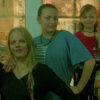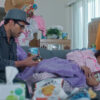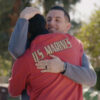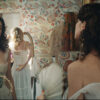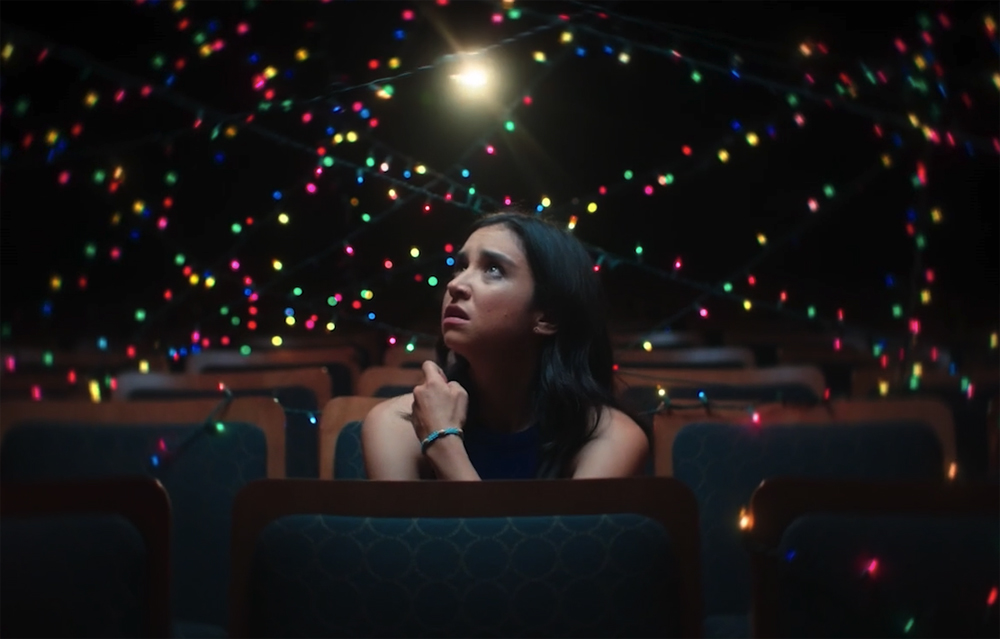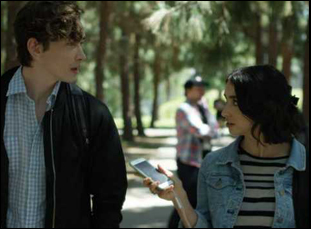There are a number of frightening things awaiting Jane (Libe Barer) back at home in “Disfluency,” leaving college just a few credits shy of receiving her degree to the puzzlement of her parents. Her sister Lacey (Ariela Barer) is quite literally waiting to pounce, hiding in the lake outside the family home in Michigan to pop up and give Jane a jump scare upon her arrival, and she is surely a little spooked by running into her estranged childhood friend Amber (Chelsea Alden) who already has a two-year-old son (Dominic Ward), but the greatest fear lies within, only gradually emerging throughout Anna Baumgarten’s compassionate debut feature in which the desire to reconnect with the world in the wake of a traumatic incident back at school is complicated by her inability to even find the words for what happened to her.
This is particularly frustrating when Jane was a linguistics major, eager to get at the roots of human interaction when she has trouble doing so herself now, even amongst her old, trusted gang of friends such as Dylan (Travis Tope), Kennedy (Kimiko Singer) and Jordan (Dylan Arnold). But Baumgarten is able to vividly articulate the feeling that her lead cannot just yet, following Jane as she enlists her friends in an informal study to hopefully secure the remaining credits need to graduate, catching every time they’ll use “umms” and “you know” to give themselves a proper pause to carry on a conversation, and ends up bonding again with Amber when she can help her learn sign language to speak to her son, who is deaf.
Although “Disfluency” takes on a weighty subject, it feels as breezy as the water coming off the Great Lakes, owing to the creativity Baumgarten brings to easing audiences into a conversation around the resulting pain that invites rather than intimidates and the ease with which her cast is able to relate to one another, with one feeling as welcomed into Jane’s circle of friends after she comes home from college as she is. That has made the film a hit at the festivals, both physical and virtual that its played from its launch at Austin Film Fest last fall where it picked up the prize for Best Narrative Feature to stops recently as the Oxford and Florida Film Festivals and coming to West Coast this Thursday as part of the Los Angeles Diversity Film Festival, the writer/director shared how she was able to build on the foundation of going back to her own hometown for her debut, enlisting real-life siblings Libe and Ariel Barer to play sisters on screen and diving into the deep end in all respects.
I had a traumatic experience in college and that’s where it stemmed from. I wrote and produced a short film, but I didn’t direct it. I didn’t feel I was ready to, but there was a lot of interest in and around the short and we got into this program, the Short to Feature Lab that’s run by Jim Cummings and Ben Wiessner. They helped us fast-track it into getting made as a feature and when it came to the feature, it was actually Laura Holliday, who directed the short, who was like “Anna, if you want to direct, this is the story. This is the time.” So she really pushed me and Jim and Ben pushed me, Danny Mooney, my producer – it was people around me that believed in me and then I took that leap of faith. So it was very homegrown and my producers and I raised the money and did the whole indie film thing.
This idea built around language and being able to articulate yourself is really novel. How did it become foundational to the story you wanted to tell?
The goal was always to explore how we communicate [because] around the topic of consent, people always have questions about communication, so it was really important for me to dive into how we talk about in and around these things. The short is also called “Disfluency” and we don’t go into different languages, like sign language – it’s really focused on just the concept of disfluency, but when we went to make the feature, I thought what’s another language element that we can include, immediately, the scene where Jade was telling someone [about her trauma] for the first time, it was in a different language outside of her own. I don’t have a background with sign language, but I considered it and I started learning it and I just fell in love because you could feel everything you say.
[Another] part I loved about that I really loved was having a young mother teach a young boy how to communicate because I feel like there is an importance in teaching young men at an early age different things, so the fact that Amber was going through this [difficult time as well] finding out that her son was deaf and [there’s] shame around it, even though there should not be, and her coming to terms with that and Jane helping her, those were the two storylines that I really wanted to get out of that.Was the young boy that plays the two-year-old Theo as patient and well-mannered as he looked?
Yeah, so Dominic Ward, who plays Theo, is hard of hearing – and that kind of casting was very important to us to make sure we had correct representation. We cast him off of pictures because when you’re casting kids and you’re moving so fast, we didn’t have a lot of time, but when he got to set, he was so patient and he was as wonderful as he came off in the film. I told his parents, “You can take this kid to Hollywood if you want. He’ll do great.”
You also have a sister act at the center – did the Barer sisters come as a package deal?
Libe plays Jane in the short and we got connected with her [initially because] I was just watching “Sneaky Pete” on Amazon, and I saw her and I was like, “Oh my gosh, she’d be perfect for Jane.” I sent [a clip] to Laura and she said, “Yeah, she’s great,” so we just got a hold of her representation and she took a chance on us and did the short film. When I went to expand it into the feature, [I said] “Hey Libe, can I write a movie for you?” and I knew she had a sister who was also an actress, so I had that conversation and I wrote the two roles for those two sisters.
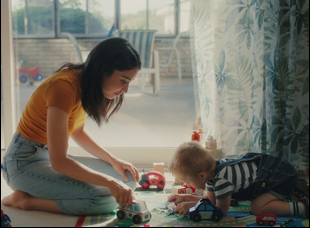
With the sisters, luckily we already had that built in. We didn’t have a casting director. We just cast based off of references, referrals, agent conversations and we got lucky in some sense that these talented actors wanted to come out and do this little project and give it so much love. Kimi [Singer], who plays Kennedy is a friend of Ariela [Barer]’s and Travis Tope came across our desk, and Dylan Arnold plays Jordan, the love interest, in the feature, but he plays the assailant in the short, so it’s like this total reverse. I had a little struggle with [that] because we had a following with the short, but I just don’t think that’s fair to [conflate] an actor for a role they’ve previously played and he was so beautiful in it and I already knew that he and Libe have that chemistry, so it was really great working with all of them.
This is filmed in a really beautiful area by the water. Was it a place you were already familiar with?
Yeah, it was shot in my hometown, so it’s very personal in that way too. The backyard and the dock, that’s my parents’ house.
You get the sense that there may be a few personal items tucked inside the production design.
Yeah, Eric, our production designer was fantastic. There’s the bunny beanie baby that’s around, that’s like one of my childhood toys. Because we shot in such personal spaces, there’s so much personal stuff in it, I could go on forever. [laughs] I didn’t actually grow up with a paddle board, but that’s something that I’ve done a lot for myself to have alone time and that’s the same paddle board I’ve used. Everything in it feels really sentimental.
A lot of filmmakers dread shooting in the water, but it didn’t look like you had any fear of that. Was that tricky to navigate those scenes of Jane out there?
It was an interesting thing to do. When we were shooting with Jane out on the paddle board, it was as many people as we needed on a pontoon boat with the camera, strapped in and my [cinematographer] on the front of the pontoon boat, shooting behind her. We got near the water a little bit with the camera – we actually put the camera in a fish tank when it was in the water. That’s how we shot under the dock and whatnot and my DP John Fisher brought a lot to the table. He’s just so talented. We definitely got very close to the water in a safe, affordable way, so that was really, really cool.
The way trauma is brought to light quite literally is also very inventive with both the quick cut editing style, but also flashing Christmas lights within certain scenes. How did that come about?
That was actually in the short too, and what I focused on a little more intensely was [having] PTSD components for all the senses, so the lights were the visual that we used and I wanted it to be something that is fairly innocent. It’s not some big, scary whatever. It’s just something [Jane] was around at the time that she is not connected to and now has this PTSD experience with.
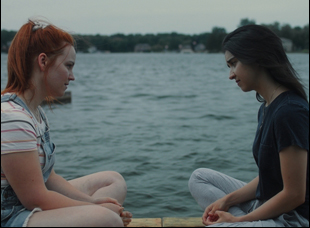
I was in the first class in 2019, so they had plans and a curriculum, but it was very loosely formatted. Once we got to Malibu [where it was held], we had a lot of time to go off on our own and work on our stuff and Jim came around and talked about story or financing or whatever we wanted. Then we were all assigned mentors [and mine] was and still is – because I adore him – Danny Madden, a really great filmmaker who did “Beast Beast,” and we had some special visitors come like Matt Miller from Vanishing Angle who gave a whole lecture on financing and all of that. But it was largely about coming together as filmmakers. We would have these dinners every night and just being together was really, really cool. I’ve visited every year since and shared my experience.
What’s it been like taking this out on the road?
It’s been so rewarding – and exhausting, especially because coming out of COVID doing the festival circuit, I went from being stationary to going to all these cities, so that was a little overwhelming. But I’ve met so many amazing filmmakers from all over the world and that’s been so cool and audiences have been receiving “Disfluency” so well. Very frequently, I’ve had people come up after and say, “Hey, I’ve had an experience and this really spoke to me. I feel like this has given me the language to express what happened to me better.” That’s really the most rewarding thing ever.
“Disfluency” will screen on April 21st at 7:30 pm at the Los Angeles Diversity Film Festival at the Laemmle NoHo and will next screen at the Riverrun Film Festival on April 26th at 7 pm at the Reynolds Place Theater and April 27th at 3 pm at the Marketplace Theater.
